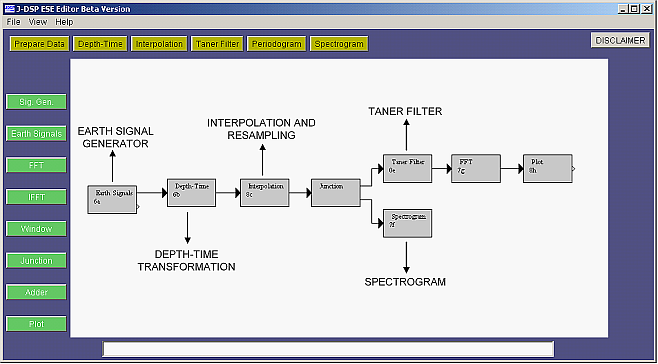Functions Developed: Total of 12 functions (blocks) are newly developed or heavily modified from the legacy Java-DSP version for the new J-DSP/ESE interface. The new JDSP/ESE interface also includes three functions from the legacy Java-DSP version with minor modifications. The total number of lines of code written or modified for this project excluding comments is approximately 5000.
1. Signal Generator: The legacy signal generator function of Java-DSP is modified to include time in kiloyear (Kyr) and frequency in cycles/Kyr.
2. Earth Signals: This block include Earth system time series including RC11-120 and its variants, Lake Baikal, Trubi Marls, Lockatong, Newark, global average temperature, and CO2 concentration. It also includes standardized time series such as ETP, Summer insolation at 30 and 65 N, precession, and obliquity.
3. FFT and IFFT: These functions are expanded from the legacy Java-DSP to support large number of points (upto 8192) and also prime factors up to a maximum value of 50 per factor.
4. Plot: This block was modified to incoporate depth, time, and frequency units.
5. Prepare Data: This is the preprocessing block with functions such as mean removal, removal of linear trend, first differencing, and truncation of time series.
6. Depth-Time: This block implements depth-time transformation using age models.
7. Interpolation: Resampling and interpolation of the time series is performed using linear, cubic, and staircase interpolation schemes. This converts a non-uniformly sampled time series to a uniformly sampled one.
8. Taner Filter: This filter is implemented as high-pass, low-pass, or band-pass using critical frequencies or time periods.
9. Periodogram: This is an extension of the periodogram block in Java-DSP and implements a Welch periodogram for signals up to 8192 in length.
10. Spectrogram: This block implements a spectrogram of the time series using the window type, window length, and sampling interval as specified by the user.
11. Coherency: Cross-coherency and cross-phase spectra are computed by this block for two signals supplied as input.
The other blocks that are incorporated in this version are Window, Junction, and Adder which are included with minor modifications.
|


